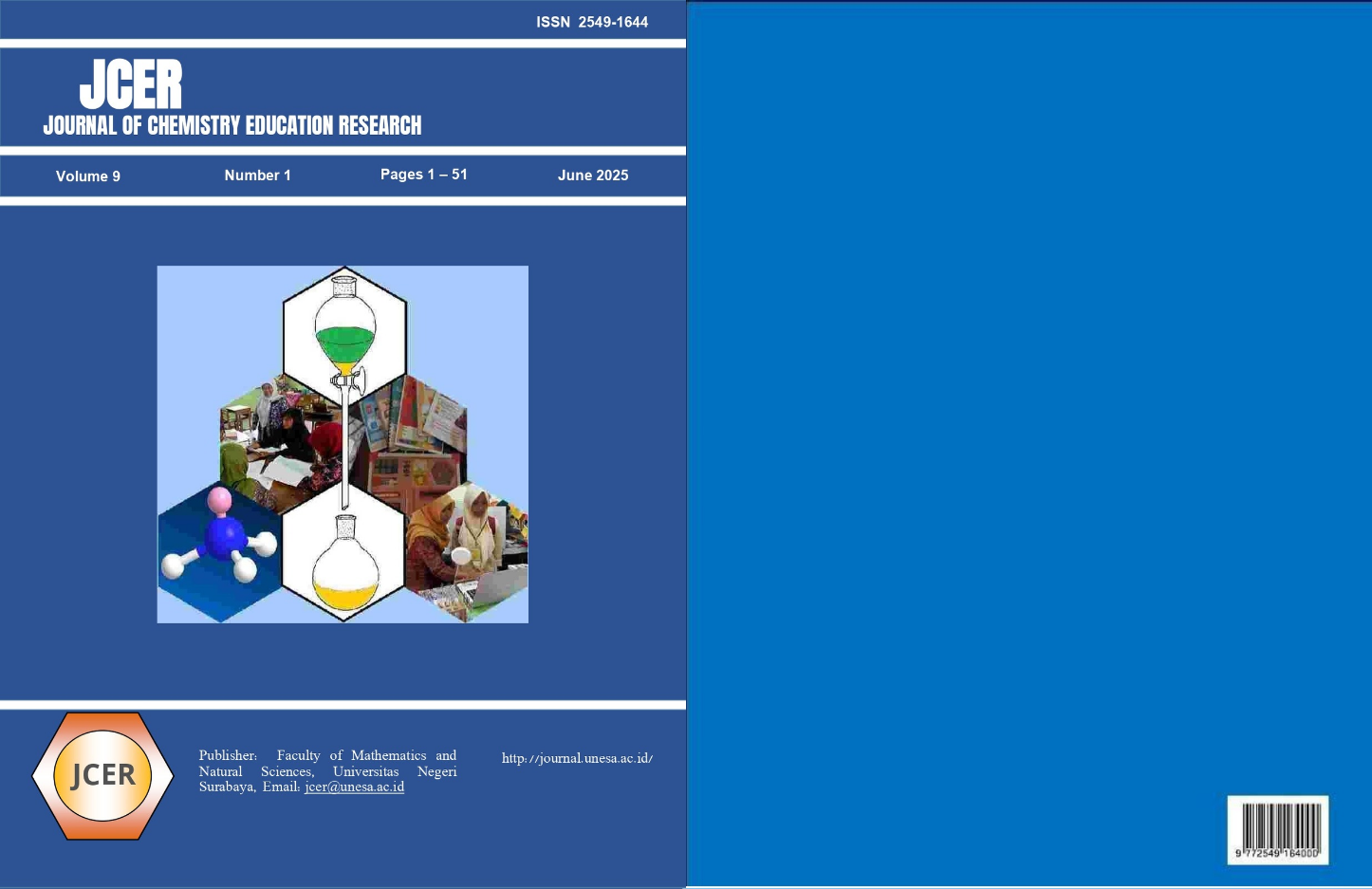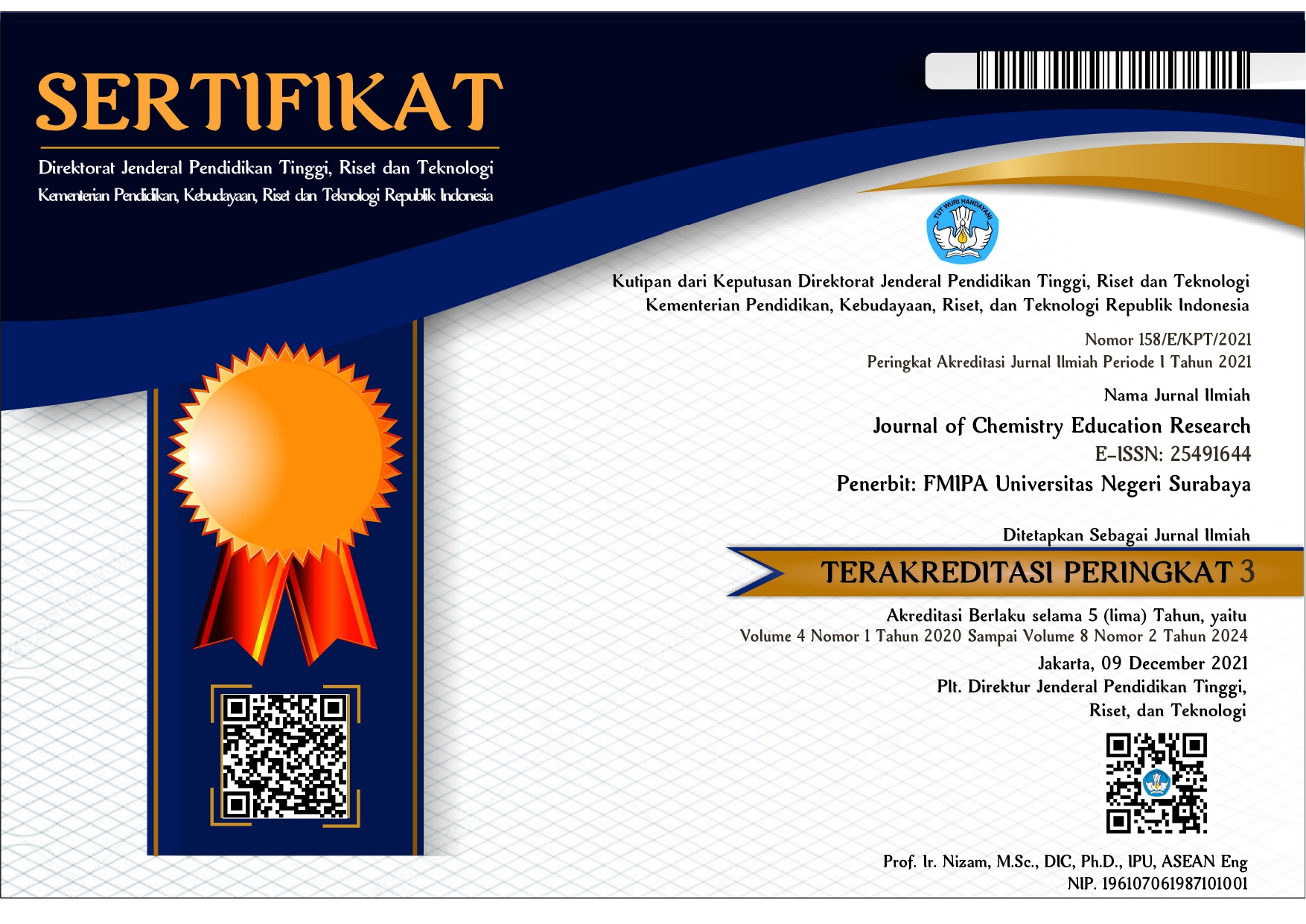INVESTIGATE THE UTILITY OF A MISCONCEPTION DETECTION APPLICATION AS AN EARLY DETECTION TOOL BASED ON FIVE-TIER DIAGNOSTICS TEST
DOI:
https://doi.org/10.26740/jcer.v9n1.p45-51Keywords:
misconceptions, five-tier diagnostic test, chemical bonding, online applicationAbstract
Research into misconceptions is crucial in the field of education, particularly in subjects like chemistry, which are complex and prone to misunderstandings. Misconceptions—ideas held by individuals that deviate from established scientific understanding—can arise from various sources, including students, teachers, textbooks, and instructional methods. These inaccuracies can hinder effective learning and need to be addressed to enhance educational outcomes. Identifying and remediating misconceptions is challenging, requiring specialized tools and methods. Therefore, research into misconceptions aims to uncover and correct these misunderstandings to improve teaching strategies and student comprehension. Therefore, the research in this article is concerned with the practicality of the application of chemical representation diagnostic tests to identify chemical misconceptions, particularly on chemical equilibrium and chemical bonding materials. This research was carried out at Surabaya State University participated by 24 students from the Chemistry Education Study Program. In this research, the practicality of the chemical misconception diagnostic test application was obtained at 98.6% which indicates that the application is practical to use. In addition, obtained data on student diagnostic results, namely: 88.3% did not understand the concept; 10.4% had misconceptions; and 1.3% understood the concept on the topic of chemical bonding.
Keywords: misconceptions, five-tier diagnostic test, chemical bonding, online application
References
[1] Arends, RI., Klicher, Ann. Teaching for student learning becoming an accomplished teacher. New York: Routledge. 2010.
[2] Berquist, W., & Heikkinen H. Student ideas regarding chemical equilibrium: What written test answers do not reveal. Journal of chemical education, 67(12), 1000-1003. 1990. https://doi.org/10.1021/ed067p1000.
[3] Kousathana, M., Tsaparlis, G. Students’ errors in solving numerical chemical-equilibrium problems. Chemistry education: Research and practice in europe. Vol. 3, No. 1. 2002:5-17
[4] Lopera, R., Calatayud, ML., Hernández, J. A Brief review on the contributions to the knowledge of the difficulties and misconceptions in understanding the chemical equilibrium. Asian journal of education and e-learning. Volume 02 – Issue 06. 2014.
[5] M. Meltafina, W. Wiji, & S. Mulyani. Misconceptions and Threshold Concepts in Chemical Bonding. Journal of Physics: Conference Series (IOPScience). Conf. Ser. 1157 042030. 2019. DOI 10.1088/1742-6596/1157/4/042030
[6] Alawiyah, Nur., & Pratiwi, Resi. Literature Study: The Phenomenon of Chemical Bonding’s Misconceptions and Opportunities for Remediation. Journal on Education. Volume 06, Issue 04. 2024: pp. 21395-21402. http://jonedu.org/index.php/joe
[7] Chi, MTH. Two kinds and four sub types of misconceived knowledge ways to change it and the learning outcomes. International handbook of research on conceptual change. Routledge. 2017.
[8] Tumay, H. Reconsidering learning difficulties and misconceptions in chemistry: Emergence in chemistry and its implications for chemical education. Chemistry education research and practice. 17 (1). 2016. 229-245.
[9] Taber, S. Keith. The nature of the chemical concept: Re-constructing chemical knowledge in teaching and learning. UK: Royal society of chemistry. 2019.
[10] Clement, J., Brown, DE., & Zietsman, A. Not all preconceptions are misconceptions: finding ‘anchoring conceptions’ for grounding instruction on students’ intuitions. International journal of science education. Volume 11, 1989 - issue 5. 1989:554-565 | Published online: 23 Feb 2007.
[11] Mushtaha, Emad., Dabous, Saleh Abu., Alsyouf, Imad., Ahmed, Amr., & Abdraboh, Naglaa Raafat. The challenges and opportunities of online learning and teaching at engineering and theoretical colleges during the pandemic. Ain Shams Engineering Journal (Pubmed). Volume 13. Issue 06. 2022. doi: 10.1016/j.asej.2022.101770.
[12] Fu, Xiaolan., Avenyo, Elvis., & Ghauri, Pervez. Digital platforms and development: a survey of the literature. Inovation and Development (Taylor&Francis). Volume 11. Issue 02-03. 2021. 303-321. doi: https://doi.org/10.1080/2157930X.2021.1975361
[13] Azizah, S. N., Akhsan, H., Muslim, M., & Ariska. M., Analysis of college students misconceptions in astronomy using four-tier test. Journal of Physics: Conference Series (ICSPE). Conf. Ser. 2165 012004. 2021. doi:10.1088/1742-6596/2165/1/012004.
[14] Febriani., Hayyun., Nilawati, Ratna., & Abdullah. Analysis of Comprehension Difficulties in Chemistry and Their Impact on Student Interest in Learning. JJEC: Jambura Journal of Educational Chemistry. Volume 06. Issue 02. 2024. 103-112. doi: https://doi.org/10.37905/jjec.v6i2.25748.
[15] Izzati, Sablia., & Rochmah, Nur., Analysis of Students’ Comprehension and Misconception towards the Topic of Salt Solubility. JPPI: Jurnal Penelitian dan Pembelajaran IPA. Volume 06. Issue 01. 2020.

Downloads
Published
Issue
Section
License

This work is licensed under a Creative Commons Attribution-NonCommercial 4.0 International License.
 Abstract views: 186
,
Abstract views: 186
, PDF Downloads: 513
PDF Downloads: 513


